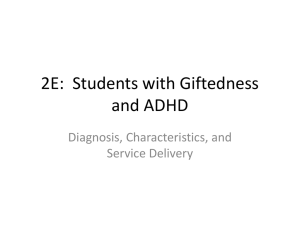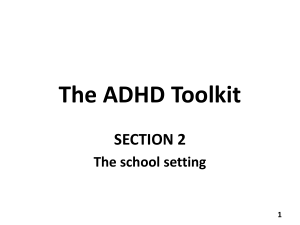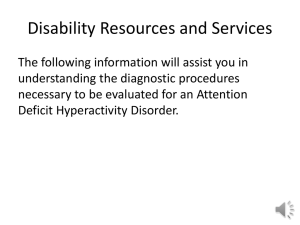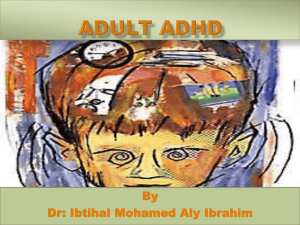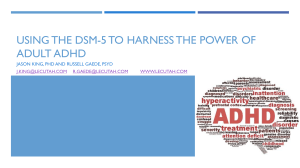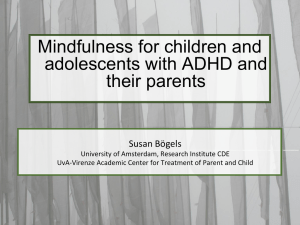Re-Conceptualizing ADHD (PowerPoint, 353 kb)
advertisement
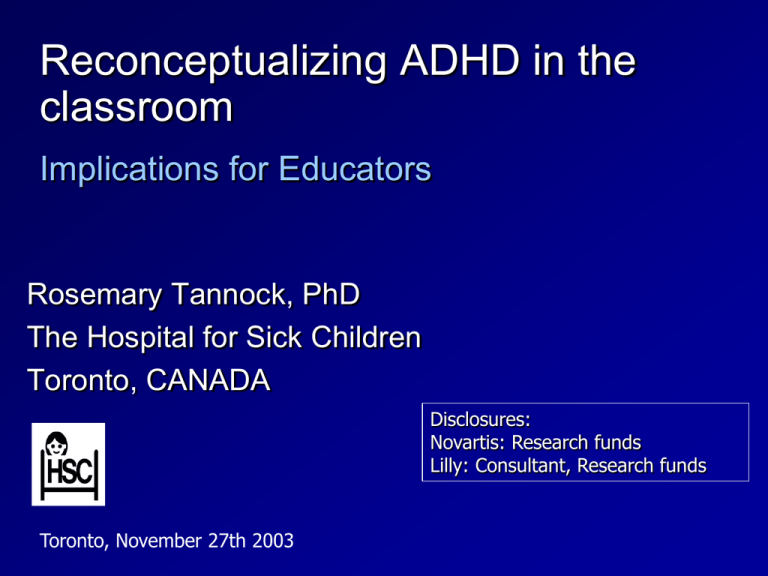
Reconceptualizing ADHD in the classroom Implications for Educators Rosemary Tannock, PhD The Hospital for Sick Children Toronto, CANADA Disclosures: Novartis: Research funds Lilly: Consultant, Research funds Toronto, November 27th 2003 ADHD: Challenges for Educational Systems Education costs 3 to 6 times greater (Forness et al., NIH Concensus, 2000) – Prevalence (1 or 2 children in every class) – Association with learning & social problems Meaning for educational programming is unclear – What type of exceptionality/special needs? – What are the Standards for level of service & instruction? – What are the required teacher qualifications? Current paradox: ADHD Clinical Perspective Construct: behavioral disorder Diagnosis & Treatment: behavioral symptoms Neuroscientific Perspective Construct: neurobiological disorder Diagnosis & treatment: neurobiological &/or neuropsychological features Reconceptualizing ADHD for the classroom Overview Overlap with LD Oral language, reading, arithmetic, written expression in children with ADHD Significance of inattention Significance of working memory problems Medical/Psychiatric: Learning Disorders “…are characterized by academic functioning that is substantially below that expected given the person’s chronological age, measured intelligence, and ageappropriate education.” (DSM-IV-TR, APA, 2000) Note: No requirement for evidence of impairment in “basic psychological processes Legal/Educational: Specific Learning Disability “…a disorder in one or more of the basic psychological processes1 involved in understanding or in using language, spoken or written, which may manifest itself in an imperfect ability to listen, think, speak, write, spell, or do mathematical calculations…” (Individuals With Disabilities Education Act, June 4, 1997, §602.26a. Emphasis added) The “psychological process criteria” are not specified. Also, most US states have operationalized the phrase - “disorders of”- as a discrepancy between ability (IQ) and achievement 1 Controversy in the Definition of LD federal/legal/educational approach – Discrepancy – Heterogeneity – Exclusion Biobehavioral systems approach – – – – Manifest disability Cognitive/psychosocial traits Environmental variables Biological variables Premise: IQ tests not necessary for the identification of LD & do not contribute to intervention planning Significant overlap between ADHD & language/learning disorders (Reviews: Cantwell & Baker, 1991; Tannock & Brown, 2000) Epidemiological & clinical studies indicate that the rates of overlap are greater than expected by chance between ADHD &… • language disorder: 8% - 30% (often unrecognized) • reading disorder: 15% - 40% • math disorder: 10% - 25% (often overlooked) • disorder of written expression (common but unstudied) • developmental coordination disorder: 10% - 50% (rarely considered) Early emergence of overlap of ADHD & oral language problems Gross-Tsur et al., 1991; Ornoy et al., 1993; Szatmari et al., 1989; Tripp et al., 1999 Delayed onset of oral language: – 6% - 30% ADHD group 1% - 6% of control group Most preschoolers (80%) exhibiting soft neurological signs & language impairments & inattention/hyperactivity, meet diagnostic criteria for ADHD & most have learning disorders (RD) at school age Longitudinal pathway of overlap between ADHD & oral language problems (McGee et al., JAACAP 1991) Epidemiological prospective longitudinal study of youngsters with “difficult to manage behavior” plus language difficulties at age 3: manifested as ADHD + reading disorders in school-age had worst outcome in terms of literacy and psychopathology in adolescence, compared to those with “difficult to manage behavior” or language difficulties, alone. The Canadian Scene: Longitudinal course of overlap between oral language & behavior problems Preschool children in Ottawa with early language delay & behaviour problems (ADHD) show higher rates of psychopathology in adolescence & young adulthood (Beitchman et al, 1982, 1997) Language Impairments in ADHD often not recognized High rate (58%) of undetected language impairments in children referred for mental health services in Ontario Subtle but impairing language problems may be obscured by more salient behavioral symptoms (Cohen et al., 1993, 1998a, 1998b) Behavior problem or communication problem in ADHD? CONTEXT: PSYCHOEDUCATIONAL ASSESSMENT Child: “What are we gonna do next? Huh? What’s in there? What’s that?” (tries to grab test materials) Adult: “You’ll see in a sec.” (reaching into case for next set of test materials) --- a few minutes later, child interrupts testing --Child: “Where’s the um…the things…um…where’s the um… bugs?” Adult: “Pardon? What bugs? There are no bugs here. Now, look at this next page and-” (child interrupts – whining then gets louder) Child: “- The bugs. You said I’ll see the bugs. I don’t wanna do this. I wanna see the bugs… the um… secs… the insecs!” Language Correlates of ADHD several behaviour symptoms used in ADHD diagnosis implicate memory and language-related deficits – fails to follow through on instructions – does not appear to be listening – blurts out answers, talks excessively – forgetful of routines What does the Research Literature Show? Studies of Expressive Language word retrieval difficulties poor conversational skills weak message coherence weak sentence formulation language in elicited responses less well-formed than spontaneous language poor organization of narratives Listening Comprehension is impaired in ADHD even in the absence of comorbid language impairments McInnes, et al., J Abnormal Child Psychology (2003) community sample of 77 boys ADHD, ADHD+LI, LI, normal main objective... – listening comprehension for spoken explanations (expository passages) – facts and inferences – ability to detect errors in explanations and descriptions – verbal and spatial working memory abilities Main Findings McInnes, et al., J Abnormal Child Psychology (2003) ADHD group (normal basic language skills) performed as well as peers in comprehending facts but were poorer at comprehending inferences - took longer to explain their understanding poorer at detecting errors in sequence of instructions had significantly poorer verbal and spatial working memory and poorer spatial memory span Also, teacher ratings of inattention symptoms were significantly related to comprehension of the passages ADHD & Reading Brock & Knapp, 1996; Cherkes-Julkowski et al., 1995; Rucklidge & Tannock, 2002; Decoding – only if have concurrent phonologically-based reading disabilities Rate – slow reading of single words & non-words, & of short passages – despite good phonological abilities Comprehension – Weak reading comprehension for science texts despite adequate decoding skills – unclear whether problems attributable primarily to slower reading rate Dual-pathways to reading problems in adolescence McGee et al, JCPP 43(8) 2002 “ADHD” Age 5-8 Hyperactivity Ages 9 -11 Inattention Ages 9 -11 Word Reading Age 7-8 Inattention Age 15 Word Reading Age 15 Data from Australian Temperament Project & Dunedin Multidisciplinary Health & Development Study ADHD & Arithmetic Computation A neglected issue Numeracy skills : • predict employment and earnings • related to health evaluation & decision making (e.g., Charette et al., 1998; Parsons & Bynner, 1997; Rivera-Batiz, 1992; Woloshin et al., 2001; International Adult Literacy Survey: Green & Riddell, 2001) Arithmetic Computation Impairments in ADHD Subtypes Faraone et al., J Am Acad Child Adolesc Psychiatry 37:185-93, 1998 120 115 COMBINED(182) 110 HYP/IMP (28) INATTENTIVE (92) 105 CONTROL (135) 100 95 a 90 a a 85 80 WISC-FSIQ WISC-3rd Factor WRATArithmetic Computation WRAT-Word reading aControls > Inatt, Combined ADHD & Mathematics Computation – Weak, even in absence of specific math disability – Multi-step computation appears particularly problematic Word problems – Difficulty with irrelevant information – Problematic even for youngsters with sub-threshold inattention (sub-clinical ADHD) Disruptive Talk or Private Speech & ADHD CONTEXT D: ARITHMETIC IN LAB CLASSROOM (Child with ADHD (9yrs old) seated alone at table with set of math computation problems to be completed in 10-min) Child: “Hmm. Two plus three… (counting on fingers) that’s two, three, four, five! (writes, erases, writes again) Twenty-nine take away…. This is hard! (stands up) Twenty-nine, twenty-eight, um… twenty-six.. uh-oh! (erases vigorously, sharpens pencil, turns to next page) Wow! Lots!(whispered. Turns back to previous page)). OK. And three..nine, ten…ah! Private speech, behavior & math computation in ADHD (Benedetto & Tannock, J Attention Disorders, 1999) During a 10-min self-directed arithmetic computation task, children with ADHD – Use immature strategies (finger counting, add-on) – Use immature (externalizing) self-talk – Exhibit low productivity – Are more inattentive & fidgety Compared to peers matched on age, IQ, & math achievement, ADHD & Written Expression Anecdotally, the most common and impairing problem at school. Characterized by……. – – – – – Low productivity, poor fluency Slow & effortful &/or fast & careless approach Poor written spelling Untidy, uneven, illegible handwriting Poor written sentence construction BUT….No systematic research to date “The presence of even a few inattentive behaviors in early childhood should be viewed as a developmental risk factor” (Warner-Rogers et al., JLD,33:2000) (Rabiner & Coie, JAACAP, 39:2000) “The presence of even a few inattentive behaviors in early childhood should be viewed as a developmental risk factor” (Warner-Rogers et al., J Learning Disabilities,33:2000) (Rabiner & Coie, JAACAP, 39:2000) Grade 1-2: – “below average” academic skills oral language, reading, written language, number concepts and computation – poor classroom adjustment low confidence, need for repeated instructions Kindergarten: – poor reading achievement in Grade 5 Significance of Inattention for cognitive processes Chhabildas, Pennington, Willcutt, J Abnorm Child Psychol, 2001 Inattention symptom cluster is the strongest predictor of neuropsychological impairments – vigilance, processing speed, inhibition Hyperactivity/impulsivity not associated with neuropsychological impairments Working Memory Helps the mind focus “an attention controller” Working Memory Multi-component cognitive system that allows us to temporarily hold and manipulate information “on-line” for a brief period (second). Permits us to maintain information temporarily in a readily accessible form while simultaneously processing new information, often in the presence of distracting and irrelevant information. This continually updated internal “on-line” record of relevant information guides decision making and overt behavior (responses) during an activity, rather than immediate sensory cues in the environment. Plays a crucial role in a wide variety of complex cognitive activities (e.g., mental arithmetic, reading comprehension) Working Memory (Baddeley, 1986; Fuster, 1995; Goldman-Rakic, 1996; Miyake & Shah, 1999) Multidimensional construct – Processes: On-line maintenance (span) Manipulation (updating, shifting) – Modality/representation: Auditory/Verbal Visual/Spatial Working memory (Brunel et al., 2001; Fuster, 2001; Gao, Krimer, Goldman-Rakic, 2001; Gutkin et al., 2001; operates over periods of seconds not localized in the brain, but rather comprises transiently activated neural networks in prefrontal cortex and other brain regions – Persistent neuronal firing in the absence of a stimulus Influenced by chemical neurotransmitters – Dopamine, noradrenaline Working memory & attention De Fockert, Rees, Frith, Lavie: Science, 291:1803-6, 2001; Conway, Cowan, Bunting, 2001; Strayer & Johnston, 2001 Working memory • The greater the working memory load, the more the individual will be distracted by irrelevant information. • Implications: individuals with WM impairments will be more readily overloaded & distractible “Driven to Distraction” (Strayer & Johnston, 2001) Dual-task studies to assess effects of cellular phone conversations on driving performance Driving performance impaired by – Concurrent tasks that placed demand on verbal working memory (e.g., in-depth conversation) & diverted attention to those activities – Not by listening to radio or books-on-tape Working memory & the cocktail party phenomenon (Conway, Cowan, Bunting, 2001) Humans exhibit the ability to attend to only part of a noisy environment, yet highly pertinent stimulus, can suddenly capture attention – In approx 33% individuals… – Those with low working memory capacity (span) Working memory & language acquisition (Baddeley, Gathercole & Papagno, 1998; Adams & Gathercole, 2000; Willis & Gathercole, 2001) Ability to maintain unfamiliar sound patterns (in the “phonological loop”) while more permanent memory records are constructed, plays a crucial role in vocabulary acquisition Children with limitations in working memory exhibit narrower repertoire of words & syntactic constructions, shorter utterances, & poorer sentence repetition Working Memory & Comprehension Daneman & Merickle, 1996; Goel & Dolan, 2001; Haenggi, Kintsch & Carpenter, 1995) Ability to manipulate (& maintain) information is essential for comprehension visual-spatial working memory critical for inferential comprehension – neural substrates for visuo-spatial processing form the basic representational building blocks used for logical reasoning in 3-term relational arguments A is in front of B; A is in front of C; thus, B is... Hypotheses Individuals with low working memory ability (maintain/manipulate) will exhibit – Greater distractibility, poorer sustained attention – Weaker oral language abilities – Poorer inferential comprehension Inattention, working memory, & academic achievement Community sample in the UK Low working memory predicts below-average performance on national curriculum in language arts and math, in 6 - 7 year-olds (Gathercole & Pickering, 2000) Potential Impact of WM Weaknesses on Language Functioning May forget what one was going to say May get confused when given complex instructions or explanations Expressive language may not be cohesive or coherent – E.g., disorganized story-telling Difficulty with turn-taking and topic shifts Impact of Working Memory Deficits on Academic Performance Difficulty thinking through problems or engaging in extensive reasoning in one’s head Difficulty understanding meaning of a sentence while decoding an unfamiliar word Difficulty implementing necessary subskills in the writing process while concurrently organizing and writing text Difficulty maintaining all relevant information in a problem and monitoring progress Working Memory is impaired in ADHD (Martinussen & Tannock, under review) Visual-spatial span & working memory – associated with severity of inattentive symptoms (Barnett et al., 2001; Brito et al., 1999; Karatekin & Arsarnow, 1998; Kempton et al., 1999; Mariani & Barkley, 1997; Martinussen et al., World Congress Psychiatric Genetics, 2002; Mealer et al., 1996; Willliams et al., 2000 Verbal working memory – inconsistent findings & may be associated with comorbid language-based learning disorders Inattention, working memory, & academic achievement Low working memory predicts belowaverage performance on national curriculum in language arts and math, in 6 - 7 year-olds (Gathercole & Pickering, 2000) It may be the combination of Inattention & Working Memory that is problematic in ADHD Proposed relationship between working memory, attention, language, & reading Biological factors Environmental factors Neurobiological Substrate Working Memory Deficits However… a cautionary note To date, there is no cognitive measure that can be used to rule in or rule out ADHD ADHD is a heterogeneous disorder – Variation in symptoms – Variation in co-existing disorders BUT! Working memory is a critical construct to understand because: – WM deficits are associated with learning problems – WM implicated in ADHD but not specific to ADHD – Seems to play a role in helping the mind focus (de Fockert et al., 2001) Clinical and Educational Implications ADHD children (with normal basic language & decoding skills) are likely to have problems in some aspects of working memory & in higher level language comprehension could these problems account (in part) for…. some behaviour symptoms reading comprehension difficulties pragmatic/ social language problems achievement problems in higher grades Major points: ADHD ADHD is a biologically-rooted neurocognitive disability ADHD is more usefully conceptualized as a type of learning disability - rather than just a behavioral problem – It is frequently accompanied by one or more specific LDs Oral language, academic, & cognitive function should be routinely assessed in ADHD Major points: Inattention & Working Memory Inattention in K/G1 should be viewed as a developmental risk factor Most classrooms will have several students who have one or more of the following difficulties: – ADHD, reading,math, language comprehension, anxiety, depression defiance,aggression Many of these students are likely to have problems with working memory, which impedes learning What are the treatment targets? DSM-IV medical perspective Brain Abnormalities Inattention Hyperactivity Impulsivity Genetic & Environmental Factors Treatment targets ? Cognitive function, learning, academic achievement Emerging neuroscience/educational perspective Brain Abnormalities Genetic & Environmental Factors Treatment targets Specific cognitive processes Inattention, Hyperactivity, impulsivity Learning, Academic achievement Implications for the Classroom Target Language, cognitive & academic problems associated with ADHD as well as behavioral symptoms Thank you for your attention! Questions



